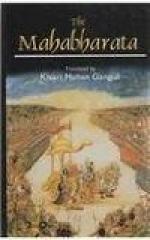364. In verse 3; vikrayartham is followed, as the Commentator rightly explains, by niyunkta or some such word. Vikrayartham hinsyat may mean ‘killing for sale.’ This, however should be pleonastic with reference to what follows.
365. Vratas (rendered as ‘vows’) and Niyamas (rendered as observances) differs in this respect that the former involves positive acts of worship along with the observance of, or abstention from, particular practices, while the latter involves only such observance or abstention.
366. The orthodox belief is that all rituals are literally eternal. As eternal, they existed before anybody declared them or set them down in holy writ. The ritual in respect of gifts of kine sprang in this way, i.e., in primeval time. It was only subsequently declared or set down in holy writ.
367. In verse 5, if instead of the reading swah, swa be adopted, the meaning would be knowing that he would have to die. A Rohini is a red cow. The words Samanga and Vahula are Vedic terms applied to the cow. The Sandh; in vahuleti is arsha. The formula or Mantras that should be uttered in actually giving away the kine occur in the scriptures.
368. The Commentator explains that gavadinam in the first line refers to gopratindhinam. The second line is very terse. The sense is that at only the eight step in the homeward journey of the recipient, all the merits attaching to vicarious gift become his who gives an actual cow: what need, therefore, be said of that merit when the recipient reaches home and draws from the cow the means of worshipping his domestic fire, entertaining his guests, etc?
369. Ashtami is the eighth day of the lunar fortnight. There must be two Ashtamis in every lunar month. A particular Ashtami is known as the Kamya or the Goshtha. On that day, kine are worshipped with sandalpaste, vermilion, floral wreaths, etc.
370. Sikhi means a bull, so called from the hump it carries. The construction is sikhi Vrishaiva etc,
371. A Kapila cow is one that gives a copious measure of milk whenever she is milked, and is possessed of various other accomplishments and virtues.
372. For without ghee, which is produced from milk, there can be no sacrifice. The sa may refer to Soma, but sacrifice is evidently meant.
373. The idea of uchcchishta, is peculiarly Hindu and cannot be rendered into any other language. Everything that forms the remnant of meal after one has left of eating, is uchcchishta. The calf sucks its dam. The udders, however, are not washed before milking the dam, for the milk coming out of them is not held to be impure remnant.
374. Swastayana is a ceremony of propitiation, productive of blessing and destructive of misery of every kind.
375. The commentator explains that by a wet cowhide is meant a piece of cowhide that has been dipped in water and thus purified. Upavisya is understood after Charmani. The mention of bhumau implies the avoidance of dishes or plates or cups of white brass or other allowable metals. Gavam pushtim, I understand, means ‘the prosperity in respect of kine.’ i.e., the prosperity which kine confer.




